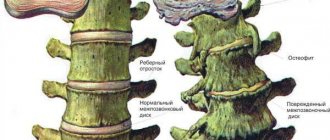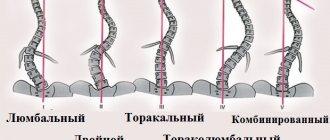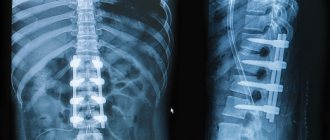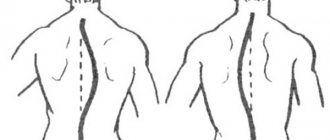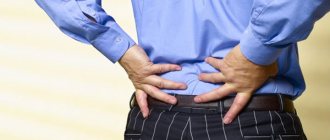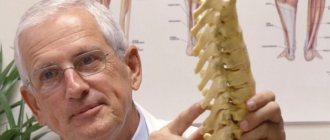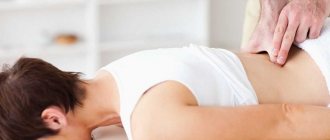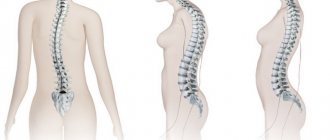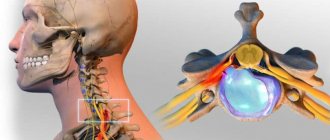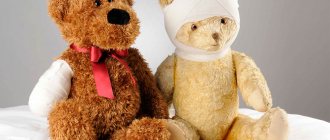Scoliosis is a curvature of the spinal column in lateral projections, which is represented by one or more bends in the frontal plane. The progression of this disease leads to the appearance of thoracic kyphosis, cervical and lumbar lordosis, deformation of the thoracic cavity and dysfunction of internal organs located in the thoracic and abdominal cavities, as well as in the pelvic cavity.
Scoliosis can manifest itself at any age; thanks to research in this area, it is possible to distinguish age groups at risk, i.e. that age period in which strict control and observation of surgeons and traumatologists is necessary:
- Infancy – from birth to 1 year;
- Children's age – 3 – 5 years;
- Youth age – 18 – 25 years.
Scoliosis
A persistent form of deformation of the spinal column is called scoliosis . Scoliosis and symptoms - pain when moving. Causes: trauma, genetics.
scoliosis treatment, scoliosis
Its main characteristic is the curvature of the spine to the right, left, or in both directions at the same time. Another characteristic feature of the disease is the twisting position of the spine around its own axis, which can lead to serious deformations in the internal organs. The disease is also dangerous because intervertebral hernias, osteochondrosis, and various diseases of the spine can appear and develop.
Prevention
In order to minimize the risk of developing pathologies of the spinal column, it is necessary:
- eat right (daily diet should be balanced);
- sleep on a hard orthopedic mattress;
- give up a sedentary lifestyle;
- do gymnastics, do exercises at least at home;
- watch your posture while walking.
Currently, the statistics are very deplorable - many children are diagnosed with kyphosis, scoliosis, and kyphoscoliosis. Parents must take care of the health of their children and try to prevent the development of these diseases.
© 2020, Golub Oleg Vasilievich. All rights reserved.
Symptoms of scoliosis
The main symptoms observed with scoliosis are impaired mobility of the spine and pain in the back that appears during physical activity. Visually, signs of the disease appear in the asymmetrical position of the shoulder blades, skewed shoulders, and the whole body may look unnaturally twisted.
The following symptoms are typical for scoliosis:
— the spinal column is deformed from 8 to 10 vertebrae;
- feeling of discomfort in the chest;
- constant pain in the back and pelvic area;
- shoulders, shoulder blades and ribs are located asymmetrically;
- reduction in motor function when tilting and turning the head;
- stoop;
- gait disturbance, possible lameness;
- dizziness, tinnitus, headache.
Varieties
How advanced can the disease be and how to avoid worsening the situation if scoliosis already exists? Timely treatment will help avoid further complications. This is why it is so important to conduct preventive examinations of children.
There are congenital and acquired scoliosis. In the first case, the cause of future problems is laid down during the prenatal period.
Due to the influence of certain factors, improper formation of the skeleton occurs. Acquired scoliosis is the result of the influence of the external environment or the internal predisposition of the body. Back injuries, too weak spinal muscles, prolonged stay of the body in an uncomfortable position - all this negatively affects the musculoskeletal system.
A child may have a C-shaped scoliosis with one arch or an S-shaped scoliosis with two arches. The most complex Z-shaped scoliosis has three arcs of deviation from the axis. Curvatures can be in the cervical or cervicothoracic region. Sometimes the location is the chest. Problems may also arise in the lumbar region.
Upon examination, the orthopedist indicates the presence of a problem. X-rays will allow you to accurately determine the degree of scoliosis. There are several methods that allow you to determine the degree of scoliosis by degrees. As the most accurate, the Chaklin scale is predominantly used.
Sometimes calculations are made using J. Cob's method. In addition, there are certain criteria approved by the Ministry of Health. The indicators vary slightly, which by and large does not affect the doctor’s conclusion. There are four stages of scoliosis. At first it is quite difficult to suspect the disease, but over time its signs become obvious. To know what changes occur in the body, let's consider them one by one.
1st degree
The first degree of scoliosis is almost impossible to notice on your own. During the examination, the doctor pays attention to the following phenomena:
- When bending down, the thigh protrudes slightly or the shoulder blade protrudes;
- In the upright position, different levels of the shoulders are noted;
- There is a slight asymmetry in the waist area;
- There is a slight stoop.
To confirm a curvature of 5-10 degrees, an x-ray is required.
The initial stage of deformation is largely a cosmetic defect. A person can continue their usual way of life. There are no symptoms, health does not worsen. But, since this pathology tends to develop, it is absolutely impossible to ignore treatment.
The earlier the problem is identified, the easier it is to stop the progression of the disease. The spinal column is a complex, unique structure. Inside the vertebrae is the spinal cord. In order for brain signals to travel ideally throughout the body, the spine must be straight. If displacement, compression or twisting occurs in any compartment, malfunctions in the functioning of various body systems occur. Even first-degree scoliosis is not as harmless as it might seem. If a distortion has occurred, it will not be possible to get rid of it; the main thing is to prevent the globalization of the problem.
The development of grade 1 scoliosis can be stopped with the help of therapeutic and preventive physical education.
Classes must be conducted under the supervision of a specialist. If necessary, a massage course is prescribed. The initial degree of the disease requires systematic monitoring. You have to visit a medical facility 3-4 times a year.
2 degrees
Progressive disease becomes noticeable. How to determine that pathology continues to develop? Over time, pronounced external signs appear. The second degree of scoliosis is characterized by:
- The bend is visible both in a bent position and in a lying position;
- There is asymmetry of the gluteal folds;
- In a vertical position, one shoulder blade is higher than the other;
- A clear unevenness in the shoulder line is visible;
- There is protrusion of the costal bones;
- The back muscles form a compensatory arch.
X-ray shows the curvature of the spinal column in the frontal plane, the angle of which reaches 11-25 degrees.
The person suffers from noticeable discomfort. The following symptoms appear periodically:
- Back pain in the lumbar region or between the shoulder blades;
- Increased fatigue;
- Frequent headaches;
- Difficulty breathing as a result of chest deformation.
Conservative medicine recommends such methods of treating second-degree scoliosis as wearing corsets, electrical stimulation of muscles, gymnastic therapy, including a set of breathing exercises, visiting a swimming pool, and massage courses. It is possible to use medications.
3 degrees
If measures are not taken in time, scoliosis develops, the stages of which pose a serious threat to the health of the body as a whole. The pathological condition leads to disruption of the functioning of internal organs.
With the third degree of spinal curvature, symptoms intensify. Pain becomes a constant companion and at some points can increase significantly. Physiologically, the following deteriorations are observed:
- Distorted pelvis;
- Strongly asymmetrical shoulders;
- Sunken stomach;
- Marked stoop;
- The appearance of a rib hump;
- Curvatures do not disappear when changing posture.
The image shows that the vertebrae move to the side by 26-50 degrees.
Treatment is carried out according to the same principle as the therapeutic course for second-degree scoliosis. In addition to physical therapy, medication is recommended. Anti-inflammatory drugs, drugs for muscle relaxation, and vitamin complexes are prescribed.
4 degrees
Pathology of the fourth degree threatens a critical deterioration in health. Such cases are the result of extreme neglect of the disease. All manifestations of scoliosis intensify to the highest degree.
Visual definition can be given by the following characteristics:
- Large rib hump;
- Obvious distortion of posture;
- Sunken belly;
- Noticeable muscle torsion.
Clinical characteristics of this diagnosis:
- Malfunctions of the cardiovascular system;
- Decreased lung volume;
- Pressure on the bladder;
- Increased intestinal flatulence;
- Congestion in the kidneys;
- Spinal cord compression.
The spine deviates from its axis by more than 50 degrees. In rare cases, curvatures can reach 60°. Treatment begins with the traditional method. For grade 4 scoliosis of the spine, surgical intervention is indicated. During the operation, the spine is straightened. To maintain the desired angle, special metal structures are inserted. After this, there will be a long period of rehabilitation and wearing a corset.
Causes of scoliosis
Curvatures of the spine (scoliosis) most often form in childhood and adolescence. It can be a consequence of injuries, complications after various diseases, or a congenital anomaly. In almost 80 percent of cases, the cause of this spinal disease is never determined. In the treatment of scoliosis, both conservative and surgical methods of treating scoliosis are used. When predicting, the degree of scoliosis, possible causes of its occurrence, the presence and severity of secondary deformations, as well as the condition of the patient’s internal organs should be taken into account.
- previous injuries;
- poor posture when sitting;
- lack of high-quality nutrition, rich in all the necessary elements for the formation of the musculoskeletal system;
- infectious diseases suffered by the mother during fetal development;
- genetic inheritance;
- disease with rickets, polio, tuberculosis, as well as cerebral palsy, dystrophy and many others;
- low-quality tumors in the back;
- overweight;
— physical inactivity.
causes of scoliosis
Spine angle
The angle of deviation of the spine or scoliotic angle is a value that allows you to determine the degree of curvature of the spinal column in degrees.
In order to measure the angle of curvature in scoliosis, an X-ray examination of the spinal column is performed in a standing position and in a supine position. The focal length for two x-rays should be the same and not go beyond 120 - 150 cm.
It is customary to distinguish between 4 degrees of scoliosis, which are determined depending on the degree of curvature. On the territory of the Russian Federation, 2 tables are used, one was compiled by V.D. Chaklin, the other was approved in 2009 by the Ministry of Health of the Russian Federation. The numbers in these tables vary somewhat.
The magnitude of the scoliotic angle for curvature of the spine according to V. D. Chaklin:
- First degree of scoliosis – 50 – 100;
- Second degree of scoliosis – 110 – 300;
- Third degree scoliosis – 310 – 600;
- The fourth degree of scoliosis is more than 600.
The magnitude of the scoliotic angle for curvature of the spine according to the Ministry of Health of the Russian Federation:
- First degree of scoliosis – 10 – 100;
- Second degree of scoliosis – 110 – 250;
- Third degree scoliosis – 260 – 500;
- The fourth degree of scoliosis is more than 500.
Complications of scoliosis
Scoliosis is especially dangerous due to its complications, which can be the following:
— disruption of the shape and normal functioning of the patient’s internal organs as a result of deformation of the chest;
- dysfunction of the respiratory system and cardiac muscle;
- deformation of the pelvic bones;
- damage to the nervous system;
- possible development of chronic diseases such as cholecystitis, ulcers, duodenitis;
- state of numbness of the limbs;
- cerebrovascular accident;
- “drying out” of the limbs;
- development of the chest hump.
Due to the fact that the consequences of scoliosis can be extremely severe, it is necessary to identify its symptoms at an early stage and begin treatment, following the recommendations of doctors.
Click here - all materials on the topic Osteochondrosis
All portal materials about Osteochondrosis are at the link in the photo above
